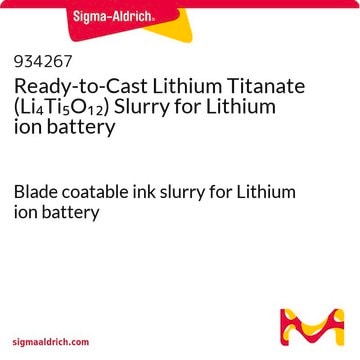About This Item
おすすめの製品
形状
powder
環境により配慮した代替製品の特徴
Design for Energy Efficiency
Learn more about the Principles of Green Chemistry.
sustainability
Greener Alternative Product
粒径
−80 mesh
環境により配慮した代替製品カテゴリ
SMILES記法
[Li+].[Li+].[O-][Ti]([O-])=O
InChI
1S/2Li.3O.Ti/q2*+1;;2*-1;
InChI Key
GLUCAHCCJMJHGV-UHFFFAOYSA-N
関連するカテゴリー
詳細
アプリケーション
保管分類コード
11 - Combustible Solids
WGK
WGK 3
引火点(°F)
Not applicable
引火点(℃)
Not applicable
個人用保護具 (PPE)
Eyeshields, Gloves, type N95 (US)
適用法令
試験研究用途を考慮した関連法令を主に挙げております。化学物質以外については、一部の情報のみ提供しています。 製品を安全かつ合法的に使用することは、使用者の義務です。最新情報により修正される場合があります。WEBの反映には時間を要することがあるため、適宜SDSをご参照ください。
Jan Code
400939-VAR:
400939-100G:
400939-BULK:
400939-500G:
試験成績書(COA)
製品のロット番号・バッチ番号を入力して、試験成績書(COA) を検索できます。ロット番号・バッチ番号は、製品ラベルに「Lot」または「Batch」に続いて記載されています。
この製品を見ている人はこちらもチェック
資料
Nanomaterials for Energy Storage in Lithium-ion Battery Applications
ナノ材料電極の実装によって、リチウムイオン電池のサイクル寿命を犠牲にすることなく、求められる出力レベルで高い放電容量を持つ電池の実現が期待されます。
HEVs address rising fuel costs and emissions concerns, utilizing battery packs alongside internal combustion engines for enhanced performance.
米国エネルギー省は、米国先進バッテリーコンソーシアム(USABC)と協力してリチウム二次電池技術を開発しており、自動車用バッテリーの性能、寿命、および事故防止・誤用対策に関して大きな改善が得られています。
ライフサイエンス、有機合成、材料科学、クロマトグラフィー、分析など、あらゆる分野の研究に経験のあるメンバーがおります。.
製品に関するお問い合わせはこちら(テクニカルサービス)













